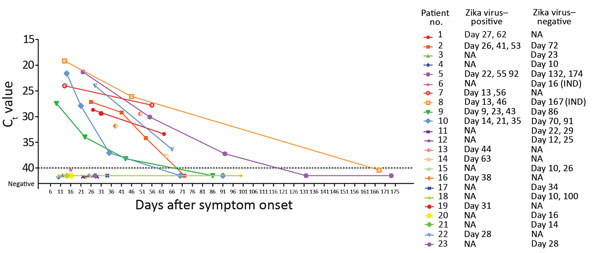Volume 23, Number 4—April 2017
Research
Presence and Persistence of Zika Virus RNA in Semen, United Kingdom, 2016
Figure

Figure. Cycle threshold (Ct) values of semen samples analyzed to determine presence and persistence of Zika virus RNA in semen, United Kingdom, 2016. All references to days indicate days after onset of symptoms. The dotted line represents the limit of detection for the assay. The lines represent implied decay rates based on longitudinal data; however, they should not be used to infer exact data between analyzed samples. In particular, the point at which viral RNA became undetected cannot be accurately inferred from the curves for patients 5, 8, 9, and 10. Patient 6 had a previous vasectomy, and patient 8 was receiving immunosuppressive drug therapy at the time of sampling. IND, indeterminate; NA, not available.
Page created: March 16, 2017
Page updated: March 16, 2017
Page reviewed: March 16, 2017
The conclusions, findings, and opinions expressed by authors contributing to this journal do not necessarily reflect the official position of the U.S. Department of Health and Human Services, the Public Health Service, the Centers for Disease Control and Prevention, or the authors' affiliated institutions. Use of trade names is for identification only and does not imply endorsement by any of the groups named above.